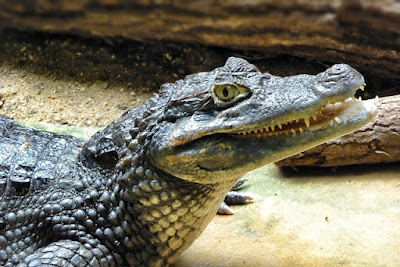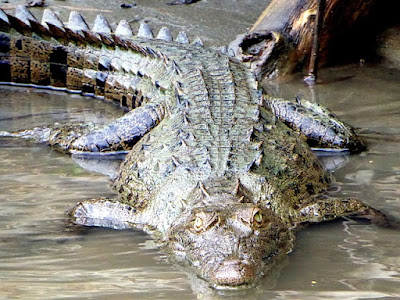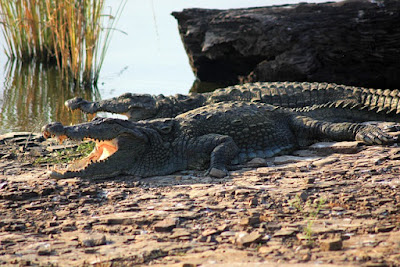Caiman: World Of Crocodiles
The caiman, a mesmerizing creature from the crocodilian family, has long captivated the imagination of both scientists and nature lovers alike. Found primarily in Central and South America, these ancient reptiles are often mistaken for their larger and more infamous relatives, the alligators and crocodiles. Despite sharing many characteristics, caimans have unique traits that make them a distinct and interesting species. In this article, we'll delve deeper into the world of caimans, exploring their characteristics, habitat, behavior, and their importance to ecosystems.
1. Caiman Features:
Caimans belong to the Alligatoridae family, and there are six recognized species: Spectacled Caiman (Caiman crocodylus), Yacare Caiman (Caiman yacare), Black Caiman (Melanosuchus niger), Broad-snouted Caiman (Caiman latirostris), Schneider Smooth-fronted Caiman ( Paleosuchus trigonatus), and Cuvier's smooth-fronted caiman (Paleosuchus palpebrosus).
Physiologically, caimans resemble crocodiles with their strong bodies and fleshy tails. They have long snouts with sharp teeth designed to hold and tear prey. For example, spectacled caimans get their name from the ridge of bone between their eyes, which resembles a pair of glasses.
2- Habitat
Caimans are primarily found throughout Central and South America in freshwater environments such as rivers, lakes, and swamps. They have adapted to a variety of habitats, from the slow-moving waters of the Amazon rainforest to the swampy wetlands of the Pantanal. These reptiles are cold-blooded, so they depend on the external environment to regulate their body temperature. As a result, they are most active during warm temperatures, basking in the sun to warm up.
3. Behavior:
Like other crocodilians, caimans are opportunistic hunters with a varied diet. Their menu typically consists of fish, birds, small mammals, and amphibians, but larger caimans may also take larger prey such as capybara and even small deer. Caimans are apex predators in their ecosystems, playing a vital role in controlling prey populations and maintaining the balance of the food chain.
During the breeding season, male caimans engage in elaborate courtship displays to attract females. Once the female lays her eggs in a carefully constructed nest, she guards them fiercely until they hatch. Mother caimans are highly protective of their young and carry the young in their mouths to water sources where they are safe from predators.
4. Conservation Status:
Like many other reptiles, caimans have faced threats from habitat loss and human activities. However, thanks to conservation efforts and sustainable management practices, many of their species are currently listed as "least concern" on the IUCN Red List of Threatened Species. The establishment of protected areas and regulations on hunting and trade have contributed to the conservation of these remarkable creatures and their habitats.
5. Human Contact:
Throughout history, humans and caimans have had a complicated relationship. In some areas, caimans are hunted for their skins, which are used to make leather goods. Although this practice has been a threat to some caiman populations, sustainable harvesting and farming initiatives have been taken to reduce the impact on wild populations.
Furthermore, caimans play an essential role in ecotourism, which attracts visitors from around the world to see these incredible reptiles in their natural habitats. Ecotourism provides an economic incentive for local communities to protect the environment and preserve caiman populations.
Caimans, with their prehistoric appearance and interesting behavior, are a fascinating part of the natural world. As we learn more about these mysterious creatures, it is becoming clear that they are not just relics of the past but essential components of the ecosystems in which they live. By understanding and appreciating the importance of caimans to their environment, we can work toward ensuring their survival and maintaining the delicate ecological balance of the areas they call home. Preserving the habitats of these remarkable reptiles is important not only for caimans, but also for the overall biodiversity and well-being of our planet.
Here are 20 interesting facts about caimans:
- Caimans are part of the crocodilian family, which also includes alligators and crocodiles.
- There are six recognized species of caimans: Spectacled caiman, Yacare caiman, Black caiman, Broad-snouted caiman, Schneider's smooth-fronted caiman, and Cuvier's smooth-fronted caiman.
- Spectacled caimans are so named because of the bony ridges between their eyes that look like spectacles.
- Caimans are mainly found in Central and South America, living in freshwater environments such as rivers, lakes, and swamps.
- They are cold-blooded reptiles, which depend on the external environment to regulate their body temperature.
- Caimans have a powerful bite, thanks to their sharp teeth, which they use to capture and tear their prey to pieces.
- Their diet consists of fish, birds, small mammals and amphibians, and larger caimans may also eat larger prey such as capybara and small deer.
- Caimans are apex predators, playing an important role in controlling prey populations and maintaining ecosystem balance.
- During the breeding season, male caimans engage in courtship displays to attract females.
- Female caimans build nests and lay eggs, and they fiercely defend their nests until the eggs hatch.
- Caiman mothers are highly protective of their young, and they carry the young in their mouths to water sources for protection.
- Some caimans, such as the black caiman, are excellent swimmers and have been known to venture into coastal marine environments.
- The black caiman is the largest of all caiman species, growing up to 5 m (16 ft) in length.
- Caimans have a life span of about 30 to 40 years in the wild.
- They have a special third eyelid, called a nictitating membrane, that protects their eyes when underwater.
- Caimans communicate through a variety of vocalizations, including hissing, growling, and screeching.
- These reptiles play an essential role in ecotourism, attracting visitors to see them in their natural habitats.
- Caimans help control mosquito populations by eating their larvae, which can be beneficial to the humans who live near them.
- The hunting of caimans for their skins has been a threat to some populations, but sustainable harvesting and farming practices have been introduced to reduce the impact.
- Thanks to conservation efforts and protective measures, several caiman species are listed as "least concern" on the IUCN Red List of Threatened Species.



Comments
Post a Comment